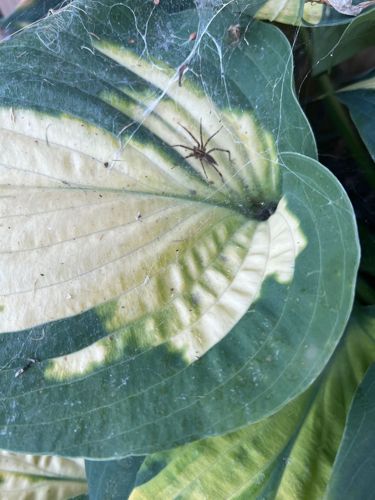Funnel Weaver
Scientific Name: Agelenidae (family)
Order & Family: Order: Araneae, Family: Agelenidae
Size: Body length typically ranges from 10 to 20 mm (0.4 to 0.8 inches) for adults, with legs extending beyond this. Some species can be larger.

Natural Habitat
Common in gardens, fields, forests, and grassy areas. They build their webs in shrubs, tall grasses, under rocks, logs, or in building foundations. The dense foliage of the Hosta plant in the image provides an ideal location for constructing their sheet-like web with a funnel retreat.
Diet & Feeding
Mainly insects and other small invertebrates that get caught in their web. These can include flies, mosquitoes, small beetles, and ants.
Behavior Patterns
Funnel weavers are known for building distinctive funnel-shaped webs, often in dense vegetation, tall grass, or crevices. The spider typically waits at the narrow end of the funnel. When an insect (or other small prey) walks across the web, the vibrations alert the spider, which then rushes out to capture it. They are generally shy and will retreat deeper into their funnel at the first sign of disturbance. Many species are nocturnal or most active during dusk and dawn. Females often stay close to their webs.
Risks & Benefits
Risks: While funnel weavers are venomous, their venom is generally not considered medically significant to humans. A bite might cause localized pain, redness, and swelling, similar to a bee sting, but serious reactions are rare. They are not aggressive and will only bite if threatened or accidentally pressed against skin. Benefits: They are beneficial predators in ecosystems, helping to control populations of various insects, including some that might be considered pests in gardens.
Identified on: 8/26/2025